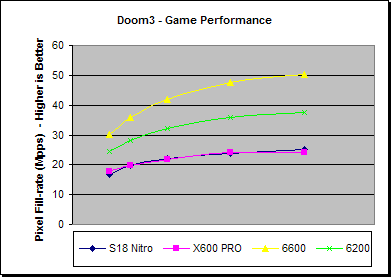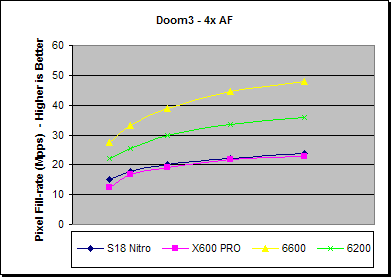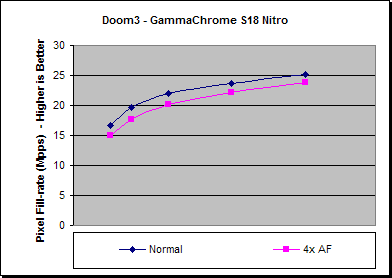Games Benchmarks - OpenGL
Doom 3
Doom3 brings a fully shader enabled environment to OpenGL, utilising the functionality of OpenGL1.3 and above. Although the title makes use of elements made available in "DirectX 9 class" hardware, Doom3's primary rendering characteristic, being its unified lighting model, requires plenty of stencil fill-rate and a lighting shader that can be achieved in a single pass per light in DirectX8.1 equivalent hardware.

| Doom3 (FPS) | 640x480 | 800x600 | 1024x768 | 1280x1024 | 1600x1200 |
| S18 Nitro | 54.2 | 41.0 | 28.0 | 18.1 | 13.1 |
| X600 PRO | 57.7 | 41.0 | 27.8 | 18.4 | 12.5 |
| 6600 | 98.3 | 74.5 | 53.4 | 36.2 | 26.2 |
| 6200 | 79.6 | 58.7 | 40.9 | 27.3 | 19.6 |
| S18 % Faster Than: | 640x480 | 800x600 | 1024x768 | 1280x1024 | 1600x1200 |
| X600 PRO | -6.1% | 0.0% | 0.7% | -1.6% | 4.8% |
| 6600 | -44.9% | -45.0% | -47.6% | -50.0% | -50.0% |
| 6200 | -31.9% | -30.2% | -31.5% | -33.7% | -33.2% |
Probably thanks to its Z/Stencil performance, in this Doom 3 test the S18 is able to keep pace with the X600 PRO, however there is still a fairly large deficit to both the GeForce boards.

| Doom3, 4x AF (FPS) | 640x480 | 800x600 | 1024x768 | 1280x1024 | 1600x1200 |
| S18 Nitro | 49.0 | 36.9 | 25.6 | 16.9 | 12.4 |
| X600 PRO | 40.5 | 35.2 | 24.4 | 16.5 | 11.8 |
| 6600 | 89.6 | 68.8 | 49.4 | 33.9 | 24.9 |
| 6200 | 71.9 | 53.3 | 37.8 | 25.6 | 18.6 |
| S18 % Faster Than: | 640x480 | 800x600 | 1024x768 | 1280x1024 | 1600x1200 |
| X600 PRO | 21.0% | 4.8% | 4.9% | 2.4% | 5.1% |
| 6600 | -45.3% | -46.4% | -48.2% | -50.1% | -50.2% |
| 6200 | -31.8% | -30.8% | -32.3% | -34.0% | -33.3% |
The GammaChrome S18 board presently has no options for enabling FSAA under OpenGL, so here we are testing all the boards with just AF enabled - in general, though, the relative performances between the boards don't change significantly from their performances under normal rendering.

| S18 Nitro (FPS) | 640x480 | 800x600 | 1024x768 | 1280x1024 | 1600x1200 |
| Normal | 54.2 | 41.0 | 28.0 | 18.1 | 13.1 |
| 4x AF | 49.0 | 36.9 | 25.6 | 16.9 | 12.4 |
| % Diff from Normal | 640x480 | 800x600 | 1024x768 | 1280x1024 | 1600x1200 |
| 4x AF | -9.6% | -10.0% | -8.6% | -6.6% | -5.3% |
In this case, enabling 4x AF reduces the performance by as much as 10%, although curiously this drops with higher resolutions.
